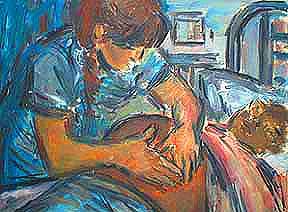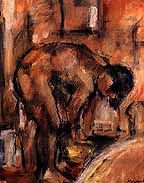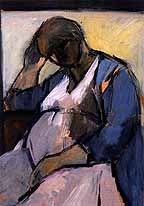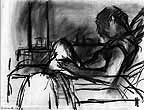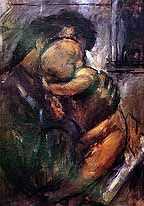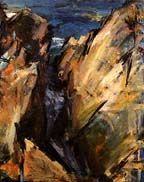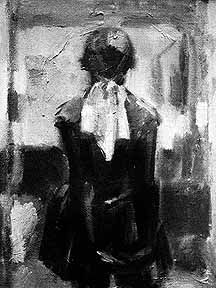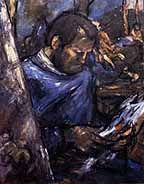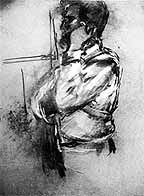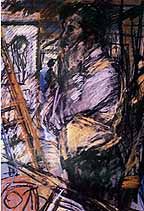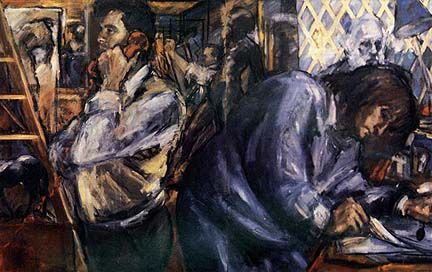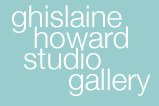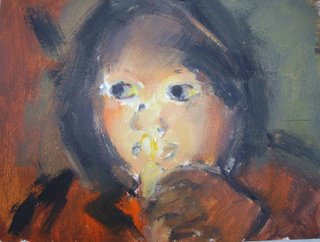|
| Features on Ghislaine Howard's working
methods:
|
| GHISLAINE HOWARD spent four
months in a Manchester maternity hospital - painting.
Jane Fickling reports Just picture the birth of twins |
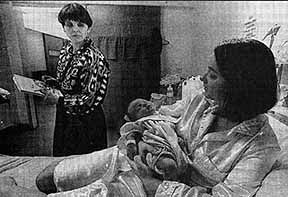 Photograph: JAMES MILNE |
| "I'm not at all brave but I found my pencil
and paper acted as a barrier between me and the blood, and I had to work
so fast to get it all down that I didn't have to think. Besides, I know
that if I did pass out no one would stop to pick me up."
War artist? Crime reporter? No, painter Ghislaine Howard has been witness and recorder to a more domestic life-and-death struggle - the emergency delivery of twins by Caesarean section. Mother and babies are doing well: "And I," says Ghislaine, "for all I thought I was detached, got a bit tearful when it was over and was on a high for days." It was the most dramatic moment of her four months spent drawing and painting expectant and newly-delivered mothers at St Mary's, the Manchester maternity hospital. From the ante-natal clinic to the delivery room, she recorded moments of tenderness, anxiety and sheer boredom.
oil on canvas 91cm x 122cm 36" x 48" Commissioned by Manchester City Art Galleries, the residency is believed to be the first of its kind in Britain. It was also exactly the kind of project which Ghislaine had been struggling to organise for some years. She had been talking to two other hospitals, one for maternity and one for geriatric patients, when the St Mary's commission was offered. Aged 39, she is primarily a portrait artist. But it was not until she became pregnant with her first child, Max, now eight, that she turned her brush on herself. "People have always been my theme," she says. "The thing that has always interested me is our shared humanity, the emotions and experiences which bind us together. My work has always been about my life and what is important to me, but even so I was surprised by the impact that pregnancy and motherhood had on me. It seemed an obvious thing to want to record, but I was surprised at how urgent the need was. "I think it was a way of making sense of the experience, getting it outside myself so that I could look at it, and also of keeping the moment forever. There seemed to be so little time. I found myself working in a much simpler, more direct way." The results are lifesize and larger-than-lifesize portraits of Ghislaine pregnant, a mother's eye-view of daughter Cordelia, now four, breast-feeding. Max struggling into his pyjamas or being tossed into the air by Ghislaine's art historian husband, Michael. She kept the same direct style for her work at the hospital, producing vigorous paintings in bold strokes of oil on canvas: "I think the work does reflect the urgency of the situation - not that it was all drama. In a hospital you get a whole range of emotions, the mundane waiting around for appointments, the day-to-day domestic routine of life on the ward, and then the drama, anxiety and elation of the delivery room." The paintings sacrifice fine detail to atmosphere and movement. Facial features are generally indistinct, although the subject matter, a baby feeding, sleeping, being born, is always examined in close-up. "I'm not a distant observer," says Ghislaine. "I think the close-up gives a sense of immediacy and that other parts of the body - the midwife's hands, for instance, or the surgeon's back - are just as expressive as the face." Her own face is elfin, topping a slight figure. Many of her canvases are considerably bigger than she is. "I am happiest working on a large scale. Painting is a very physical activity for me - my whole arm goes into it." Born in Eccles, Ghislaine trained at Newcastle University and then worked in London for a time. But for the past seven years the Howards have lived in Glossop, Derbyshire, and since she moved there she has discovered a growing interest in landscape painting. Her style translates easily. She favours strong but sombre colours. Remove the head and her painted torsos assume an elemental air reminiscent of the stark hills and valleys above her home. She works in an airy, not to say chilly, studio overlooking the river running through a deep cleft behind her stone cottage. While her children were small she learned to work in whatever brief spaces of time she could snatch, but now the house is blessedly peaceful during the day. In fact, it can become too peaceful - hence her plans for more hospital work, this time in the geriatric wards of the Shire Hill Hospital near her home. "I do have a need to get out and work with people," she says. "And I am fascinated by old faces, by the way a face changes as it becomes old, and the experiences that shape it. I spend a lot of time just talking to the patients at Shire Hill. It is a privilege to be allowed to share the intimate moments of people's lives." The Daily Telegraph,
29 January 1993
|
 Photograph: ANNE-KATRIN PURKISS |
GHISLAINE HOWARD talks to
Philip
Vann about painting her family and wider subjects
'Even though some of my paintings of parenthood are very big and monumental, I do not lose the sense of the particular, of intimacy and tenderness' |
| Your son Max was born in 1984 and your daughter,
Cordelia, in 1987. How has this affected your life as a painter?
Before the birth of my son, I used to waste so much time. Since then it's been a balancing act all the time. I remember when Max was tiny and I had a portrait commission, and I ended up painting with him in a sling support on my front. But the business of shortage of time has concentrated my mind tremendously, so that now I can make good use of any amount of time. When Max was born, I'd been offered a big exhibition at Salford City Art Gallery. I was so desperate that the birth of this child wasn't going to stop me working, that I said I'd have the show when he was six months old. So every time he shut his eyes I would be painting away like mad. There were times when I found it difficult and stressful, but looking back, I did enjoy it. A lot of the work then was based on him and my feeding him, so it did seem to fit in fairly naturally. I found reserves I didn't know I had. How do you cope with interruptions in the studio? When I paint, it's a very concentrated and quite frenzied activity, totally absorbing. I need to know I'm not going to be interrupted, even if it's only 15 minutes. I think 'I've got time' and the dog starts up an awful caterwauling and the phone rings! When Sesame Street was on television, every day at one, my children sat and watched it. That was a precious hour when I could work. My studio is attached to the house, but it's slightly apart, which is important. The building was originally a tripe factory! When I used to work in the front room at home, I could hear everything going on, but now it's very quiet.
I studied art at Newcastle University, and looked a lot at Titian and Delacroix. I wanted then to paint very significant, dramatic pictures, scenes from novels and poetry, for instance, and was left very much to myself to do that. When I went to London as a postgraduate, I suffered quite a loss of confidence. I did a lot of reflective self-portraits and interiors. When I came back north, to my roots as it were, my work started to gain momentum and became more focused. I'd always been interested in painting the figure, but being pregnant and having children added a sense of urgency, also the sense of sharing a common condition. In a way, I don't see my landscape paintings as separate from my mother and child paintings. Since I moved back to Lancashire in 1980, the landscape has become very important. I think the landscape informs my figurative painting and has helped it to develop. I go for strong, monumental pieces of landscape, like stormy seas and cliffs, not attempting to paint them in a purely representational way. In 1984, during your first pregnancy, you made a striking series of autobiographical paintings and drawings. How conscious were you that this a rarely-depicted subject? Do you paint other women and their children? Yes I've done, for example, a lot of drawings of a friend feeding her new baby. Manchester City Art Gallery bought one of these. I do very many life drawings, studies from the human figure, which is the backbone of my art. Even though some of my paintings of parenthood are very big and monumental, I do not lose the sense of the particular, of intimacy and tenderness, little details like the tiny hand being held in the big adult hand, or the interplay between the feet of the mother and of the new child. Some of your most moving pictures are of shared
moments between your husband and your children.
In painting and drawing, what are your preferred materials? I don't find pencil very sympathetic to work with. I use scene painter's charcoal, and broad director's brushes, made from hog's hair. For me, painting is a very physical process. I like using the whole arm, putting my whole self into it. I like best very coarse, heavy flax canvas, which I stretch to size. Initially in a painting I draw in simple shapes, the basic structure, with very rapid movements, add fairly thin washes of paint, then rework the charcoal into the paint. Next, I start to apply thicker paint in areas that seem to be the mainspring of the composition, pivots in the structural scaffolding, like here, the shoulder, there the neck. I use a palette knife to scrape off paint where need be, redefining all the time with charcoal. When do you consider a work finished? There's no way I'm seeking a static, finished object. In some pictures you can see, for example, that an arm has been in two or more different positions, and very often I'll leave that out because I'm happy for a record of the making of the picture, traces of movement, to be left. There is often a dialogue between the raw canvas and heavily worked areas. From underpainting, all sorts of colours come through. Do you paint en plein air towards landscape paintings? Living and working near Manchester, what relationship do you have with the London art world? As a northern artist, in terms of exhibitions and sales, you have to go to London. I really recovered my confidence coming back north to live, and I was very chary then about the London art scene. It's a question of waiting till you're ready, though even then it's very hard getting to exhibit in London galleries. In 1991, I had an exhibition at the Boundary Gallery in St John's Wood, and recently I showed some works at the Bruton Street Gallery in Mayfair. When you're painting away, you don't necessarily think about all the tedious, mundane tasks that you wish somebody else would do for you: photographing works, sending out slides, keeping an eye out for open exhibitions, sending in paintings, approaching galleries, sorting out framing and so on. It's necessary to promote yourself. If your paintings just sit in the studio racks, you're not communicating anything. You have to make a bridge between yourself and the public. The only way you can do that is by working with the galleries, the middlemen. How do you see the future development of your work? I'm now working on drawings towards a series of paintings on the theme of 'Stations of the Cross', concentrating on the single figure. I've recently been offered a Residency by the Manchester City Art Gallery in a maternity unit in a local hospital, leading to a show at Manchester City Art Gallery in early 1993. It's very exciting having the opportunity to tackle the same intimate subject matter I have always done but in a wider, more public context. These ambitious new works complete a cycle, bringing me back to the preoccupation of those artists I have always loved, namely depicting our common, vulnerable humanity. The Artist's and
Illustrator's Magazine, October 1992
|
| The Degasists
(Two
canvases) Final stage
oil on canvas 56" x92" 142cm x 234cm
|
Ghislaine Howard Studio Gallery
A Shared Experience Landscape Parent and child Pregnancy Self-portraiture The Empty Tomb The geriatric unit The intimate and the domestic The maternity unit The prison The St Anthony Cycle The Stations of the Cross The theatre The Visitation Wardrobe Working methods |

